Improving understanding of the extent and distribution of Vulnerable Marine Ecosystems in the deep waters around Scotland
Scotland’s deep sea: a hotspot for marine biodiversity
Scotland’s deep sea comprises the Faroe-Shetland Channel to the north of the Scottish mainland and the Rockall Trough and Hatton-Rockall Basin to the far west, covering an area four times bigger than the land mass of Scotland and reaching depths in excess of 2,000 m.
Scotland’s deep sea is characterised by large expanses of soft sediments and several steep submarine ridges such as the Rockall Bank (Figure 1A) and underwater mountains known as ‘seamounts’ including Rosemary Bank, which is taller than Ben Nevis (Figure 1C). The interaction between deep-ocean currents and these topographically distinct features that protrude from the seabed provide the perfect habitat for some of the most vulnerable and slow growing species on earth.
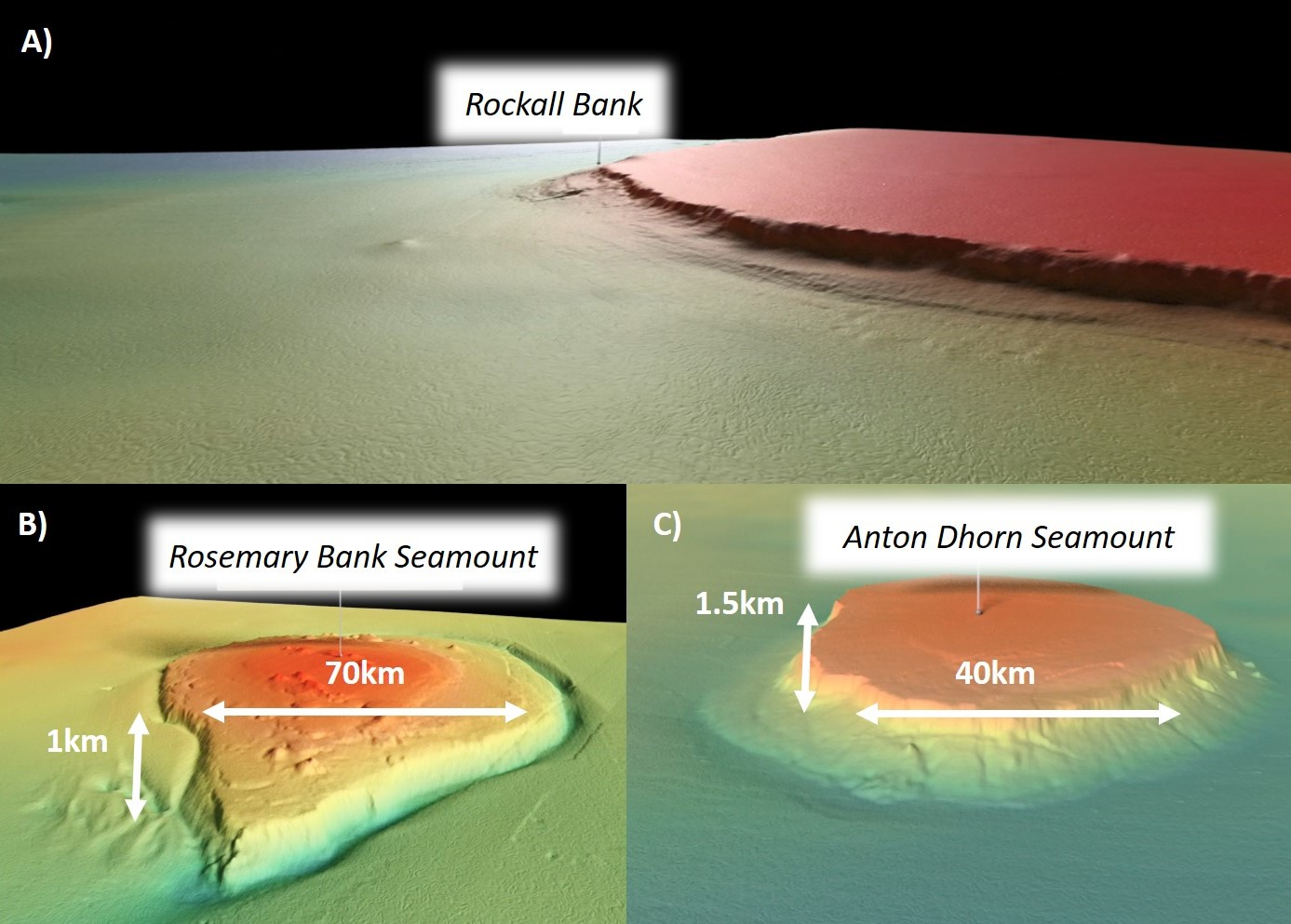
The habitats that characterise Scotland’s deep sea include reefs and gardens of cold-water corals, aggregations of deep-sea sponges, and sea-pens (a type of soft coral) that protrude up to 2 m from the muddy seabed in search of passing food (Figure 2). Collectively, these fragile habitat types have now been categorised as ‘Vulnerable Marine Ecosystems’ (VMEs) (FAO, 2009). Many of these features are considered to be under threat and subject to decline right across the North-east Atlantic a result of anthropogenic activities such as fishing (OSPAR, 2008).
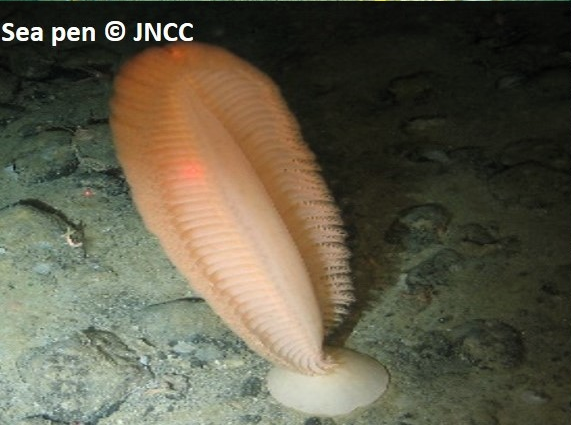
These habitats support a biologically rich environment for many marine species such as whales and dolphins. For example the Rosemary Bank seamount attracts aggregations of fish such as blue whiting as a result of the phenomenon known as topographic focusing of prey (Bailey & Thompson, 2010) which in turn attract large schools of various marine mammals (Weir et al., 2001).
A brief characterisation of Scotland’s deep-sea VMEs
There are five types of VMEs found in Scotland’s deep-sea. Since publication of the first Marine Atlas (Baxter et al., 2011), understanding of the extent, distribution, ecology and functional importance of these fragile marine ecosystems has increased significantly. A brief summary of these VMEs in terms of their characteristics and general distribution across Scotland’s deep sea is provided below (after Tyler-Walters et al., 2016).
Carbonate mound communities
Carbonate mounds (Figure 3) are steep-sided mounds of varying shape, which may be up to 350 m high and 2 km wide at their base. They often have a sediment layer composed of carbonate sands, muds and silts and host diverse communities of deep-sea organisms. These include cold water reef building corals (e.g. Lophelia pertusa), sponges, bryozoans, soft corals, sea squirts, tube worms, sea-firs, feather stars, and bivalve molluscs. The only known instances of this VME are to the far west of Scotland on Hatton Bank (Figure 8).
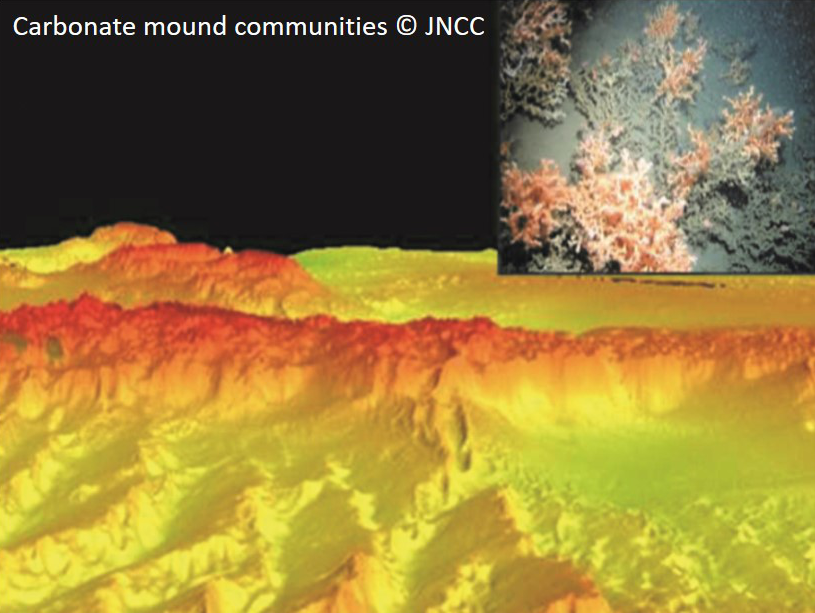
Cold-water coral reefs
The cold-water coral (Lophelia pertusa) forms reefs (Figure 4) that can be up to several kilometres long and more than 20 m high. Lophelia reefs often occur in association with other hard corals (e.g. Madrepora oculata and Solenosmilia variabilis) and the redfish (Sebastes viviparous). They support extremely rich assemblages of invertebrates - particularly starfish, sea urchins, anemones and squat lobsters (e.g. Munida sarsi). This fragile habitat type is now widely recorded across Scotland’s deep sea notably at Rockall, Hatton and George Bligh Banks, and Anton Dohrn, Rosemary Bank and Hebrides Terrace Seamounts. Cold-water coral reefs are also recorded on the Wyville-Thomson Ridge and Darwin Mounds (Figure 8).
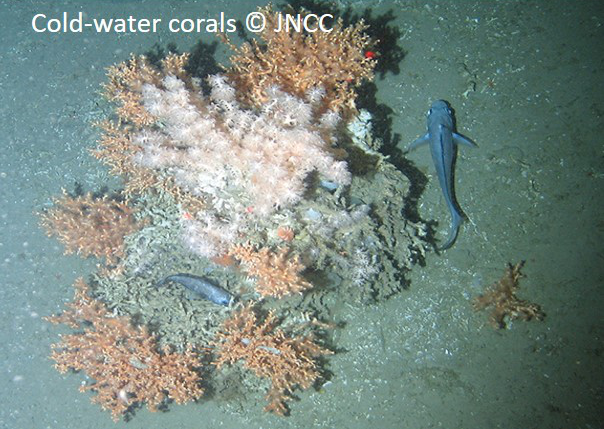
Coral gardens
Coral gardens are highly diverse, comprising dense aggregations of colonies or individuals of one or more coral species (Figure 5), which in some locations may reach densities of between 100 and 700 colonies per 100 m2. Where reef-forming corals occur, they settle in scattered clumps or small colonies and do not dominate the habitat type. Animals typically associated with coral gardens include basket stars, brittlestars, feather stars, molluscs, crustaceans and deep-water fish species. Coral gardens are recorded from Rosemary Bank and Anton Dohrn Seamounts, Rockall, and Hatton Banks (Figure 8).
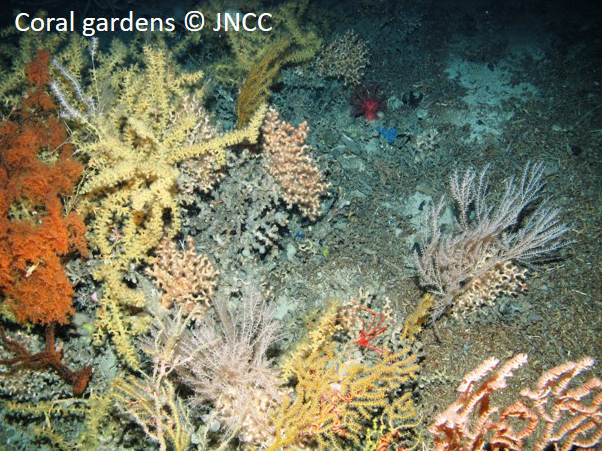
Deep-sea sponge aggregations
Deep-sea sponge aggregations (Figure 6) are principally composed of glass sponges (Hexactinellida) and giant sponges (Demospongiae) that greatly increase habitat complexity that supports diverse biological communities. They provide shelter for a range of tiny animals seeking protection and an elevated perch for filter feeding animals such as brittlestars. The dense spicule mats associated with sponge communities are also thought to support their own special rich community of species. Deep-sea sponge aggregations occur across northern parts of the Faroe-Shetland Channel. Fields of the glass sponge, Pheronema carpenteri, are also recorded from the Hatton-Rockall Basin. Other records include stalked sponge grounds at the base of the Hebridean continental slope in the Rockall Trough, and encrusting sponge dominated aggregations from Rockall Bank (Figure 8).
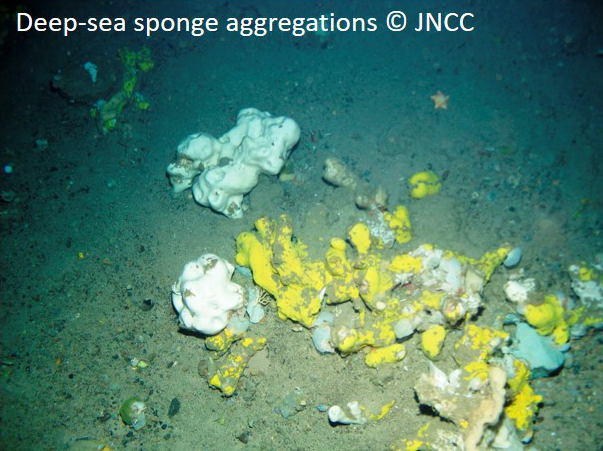
Seamount communities
Seamounts have been described as ‘hotspots’ for marine life (Figure 7). The presence of an exposed hard substrate for marine life to settle on, and the effect of their size and relief on oceanic currents create ideal conditions for a range of suspension feeders. They form the basis of seamount communities which comprise cold-water corals (principally Lophelia pertusa), coral garden species (such as black corals, lace corals and bamboo corals) and deep-water sponges. Concentrations of deep-water fish species, such as orange roughy (Hoplostethus atlanticus) and blue ling (Molva dypterygia), aggregate around seamounts and live in close association with the benthic communities they harbour. The biological richness of seamount communities is also attractive to spawning aggregations of fish which draw top predators including a range of shark species and cetaceans. There are three seamounts recorded in Scotland’s deep-sea area: Rosemary Bank, Hebrides Terrace and Anton Dohrn (Figure 8).
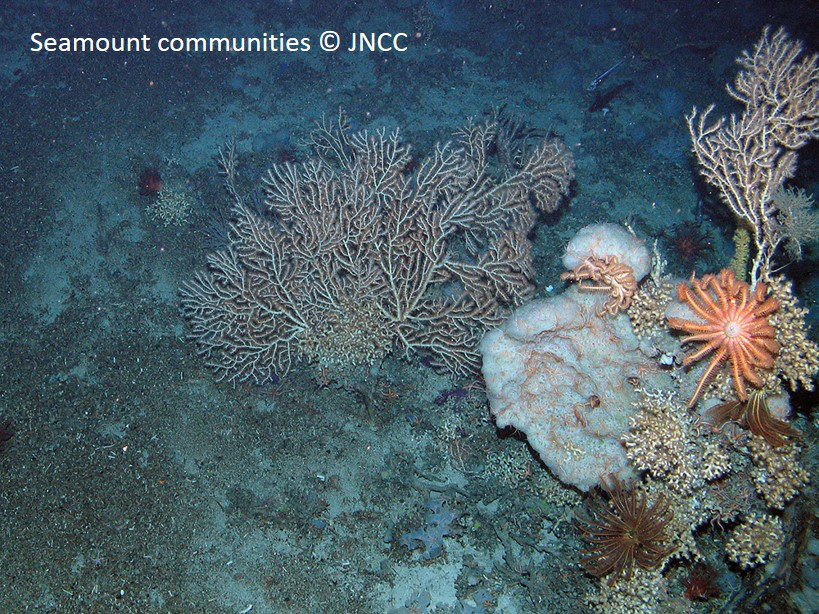
Improving understanding
Since publication of the first Marine Atlas (Baxter et al., 2011) the understanding in terms of the extent, distribution, ecology and functional importance of the deep sea habitats and associated communities around Scotland has improved significantly. Figures 8 and 9 show changes in improved understanding of the distribution of the five VME habitat types in Scotland’s deep-sea area.


Between 2011 and 2018, a significant number of deep-water surveys, characterisation studies and new research projects have improved the understanding of the distribution, ecology and functioning of VME habitats in Scotland’s deep sea:
- In 2012, a cruise to the Faroe-Shetland Channel and Wyville-Thomson Ridge greatly increased the understanding of the distribution of the Boreal ostur form of deep-sea sponge aggregations in the Faroe-Shetland Channel (Eggett et al., (2018).
- In 2014, characterisation studies increased the understanding of deep-sea ecosystems by refining the habitat definition of coral gardens (Henry & Roberts, 2014a) and deep-sea sponge aggregations (Henry & Roberts, 2014b) and verifying suspected records of these habitat types.
- The 2014 MOREDEEP survey, focused on the eastern slopes of Rosemary Bank, discovered the presence of extensive sponge grounds occurring at depths of between 1200 and 1400m (McIntyre et al., 2016).
- In 2015, a Marine Scotland Science survey to the Rockall Trough area documented the presence of the first cold seep habitat within the UK (Neat et al., 2018).
- In 2016, the Deep Links project started collecting data on the connectedness of deep-sea ecosystems (Deep Links Project 2016)
- In 2017, a cruise to the Faroe-Shetland Channel and Wyville Thomson Ridge started to gather evidence for site condition monitoring of the protected features of deep-sea MPAs (Taylor et al., 2019a).
- In 2018, a cruise to the Faroe-Shetland Sponge Belt, Rosemary Bank Seamount and Wyville Thomson Ridge gathered initial data for site condition monitoring which would better inform and support future monitoring efforts (Taylor et al., 2019b).
- SpongGes project is a four-year international EU-funded project that aims to research, preserve and sustain dee-sea sponge ecosystems in the North Atlantic and will be running till 2020.
- ATLAS is a four-year Trans-Atlantic EU-funded project (2016-2020) that focuses on developing an integrated basin-scale assessment of Atlantic deep-water ecosystems and their Blue Growth potential. There are three case-studies located in Scottish waters: Faroe-Shetland Channel, Rockall Bank and Mingulay Reef Complex.
A resource for society that is worth protecting
Whilst not on our doorstep, the biodiversity which characterises Scotland’s deep sea has much value to people's everyday lives. Scotland’s deep-sea environment performs many vital functions such as storage of greenhouse gases, habitat for commercially important species and an important role in global hydrodynamics and climate regulation:
Implementing spatial protection measures to conserve and recover Scotland’s deep-sea biodiversity
Despite its remoteness, the deep sea is still affected by human activity and wide-spread ecosystem changes are already evident (Benn et al., 2010). Deep-sea fishing has a major impact on the health of deep-sea ecosystems through both physical damage from fishing methods to functional damage from overexploitation (Benn et al., 2010; Armstrong et al., 2019). Damage can affect the extent and distribution of these ecosystems as well as the physical structure they provide to other species. Biogenic reefs, alongside other VMEs including deep-sea sponge aggregations and coral gardens, are vulnerable to not only physical damage but also increased resuspension of sediment from the use of bottom-contacting fishing gear. VMEs are under threat from direct anthropogenic factors and indirect climate-change related factors. Deep-sea organisms typically experience far more stability in terms of water temperature, salinity, oxygenation and currents than their shallow-water counterparts and thus may not be able to tolerate even small changes in these environmental parameters (Hughes & Narayanaswamy, 2013).
There are a number of mechanisms for protecting VMEs in Scotland’s deep sea. At the international level, the Food and Agricultural Organization (FAO) has developed guidelines for the management of deep-sea fisheries in areas beyond national jurisdiction which were adopted in 2008. The guidelines provide an internationally agreed set of criteria for identifying VMEs and suggestions for management actions to take once an area has been identified as vulnerable.
The International Council for the Exploration of the Sea (ICES) holds a VME database containing observations of VME indicators and habitats across the North Atlantic and provides scientific advice to governments. These data are used to develop deep-sea fisheries measures to help protect VMEs. Between 2004 and 2011, three deep-sea fisheries management measures were introduced in Scottish waters: EU Darwin Mounds closure (2004); NEAFC/EU North West Rockall Bank Box (2007) and NEAFC/EU Rockall Haddock Box (2009), aimed at protecting and sustainability managing key Scottish fisheries.
Between 2011 and 2018, an additional six fisheries management measures have been implemented in the Scottish waters including EU Blue Ling protection areas (2013) and an EU-wide Deep-sea Fisheries Regulation (2016/2336) which prohibits trawling in waters greater than 800m. The regulation also prohibits fishing with bottom trawls in areas between 400-800m where VMEs are known to occur or are likely to occur. NEAFC acts outside of the UK EEZ and so their remit is outside the 200nm line in the area of extended continental shelf claim.
At a national level, Marine Protected Areas (MPAs) play a role in protecting VMEs from external threats such as fishing and other anthropogenic disturbance. Implementing MPAs has become a key tool in Scotland’s commitment to safeguarding and enhancing biodiversity in Scottish seas. Deep-sea MPAs are one element of creating a representative and ecologically coherent wider MPA network.
The Marine (Scotland) Act (2010) and the Marine and Coastal Access Act (2009), provide the legal mechanism to help ensure clean, healthy safe, productive and biologically diverse oceans and seas by putting in place a new system for improved management and protection of the marine and coastal environment. These build on existing domestic legislation underpinning environmental protection in Scotland’s seas. For example the regulations that implement the EC Habitats Directive for designating Special Areas of Conservation (SACs) and EC Birds Directive for the designation of Special Protection Areas (SPAs).
In 2011, there were three SACs designated in Scottish deep-sea waters (Figure 10). Since then, an additional three SACs were designated in the deep sea in 2012, followed by 30 Nature Conservation MPAs in 2014, of which six are for deep-sea ecosystems. These designations are the result of a comprehensive ecological network assessment, stakeholder engagement and public consultation through collaboration between Scottish Government, JNCC and Scottish Natural Heritage. Together, this culminated in 12 deep-sea MPAs designated by the end of 2018, compared to three in 2011 (Figure 11). At the end of 2018, the deep-sea habitats protected through MPAs in Scottish waters covered a total area of 70,857 km2, compared to 7,487 km2 at the end of 2011. This equates to approximately 11.5% of total Scottish waters designated in deep-sea MPAs in 2018.


Work to further spatial protection efforts in Scotland’s deep sea is ongoing. The 2018-19 Programme for Government (Scottish Government, 2018) included a commitment to consult on the creation of a national deep-sea marine reserve to complement the existing MPA network in Scottish waters. The use of large-scale MPAs such as marine reserves reflects ambitions for a more ecosystem-scale approach to marine conservation in the deep sea (Wilhelm et al., 2014). Indeed, large-scale MPAs offer the opportunity to explore conservation opportunities for wider components of the marine ecosystem such as mobile species such as deep-water fish, cetaceans and birds.
Knowledge gaps
Recently, there has been an increase in research around deep-sea ecosystems, how they are impacted by pressures and what effects this might have on their function and the services they provide. Despite these new advances, understanding is still limited with many questions yet to be addressed. Some of the key knowledge gaps include the ecology, taxonomy and distribution of deep-sea sponges and corals in the Scottish waters (McIntyre et al., 2016), the effects of climate change on VMEs, and how deep-sea ecosystems are connected (Chaniotis et al., 2019). This information is needed to develop models and predict shifts in deep-water ecosystems and populations and to implement appropriate designs and strategies for spatial protection. Opportunities to develop further MPA and fisheries management options, adopting emerging alternative conservation options and incorporating the concepts of natural capital and ecosystem services need to also be considered.
There is a need to improve the capacity to monitor the deep-sea. However, the costs of new technologies and a limited ability to share data in a timely and efficient manner across sectors are barriers to furthering understanding. This can be overcome by supporting collaborative research efforts and engagement with industry to share knowledge and resources (Chaniotis et al., 2019).
Scotland’s deep sea area is around four times bigger than the land mass of Scotland and includes everything beyond the continental shelf break at around 200 m deep to areas in excess of 2,000 m depth. It has remained largely unexplored until recently with the development of acoustic survey techniques and Remote Operated Vehicles it has begun to reveal its secrets.
The Predicted extent of physical disturbance to seafloor assessment uses the degree of exposure to demersal fishing activity as a proxy for habitat condition. The Case study: Deep sea vulnerable marine ecosystems highlights the growing wealth of information about the distribution and diversity of habitats and species in Scotland’s deep sea area, including carbonate mounds, cold-water coral reefs, coral gardens, sponge aggregations and seamount communities whilst revealing that there is still much more to be discovered.


